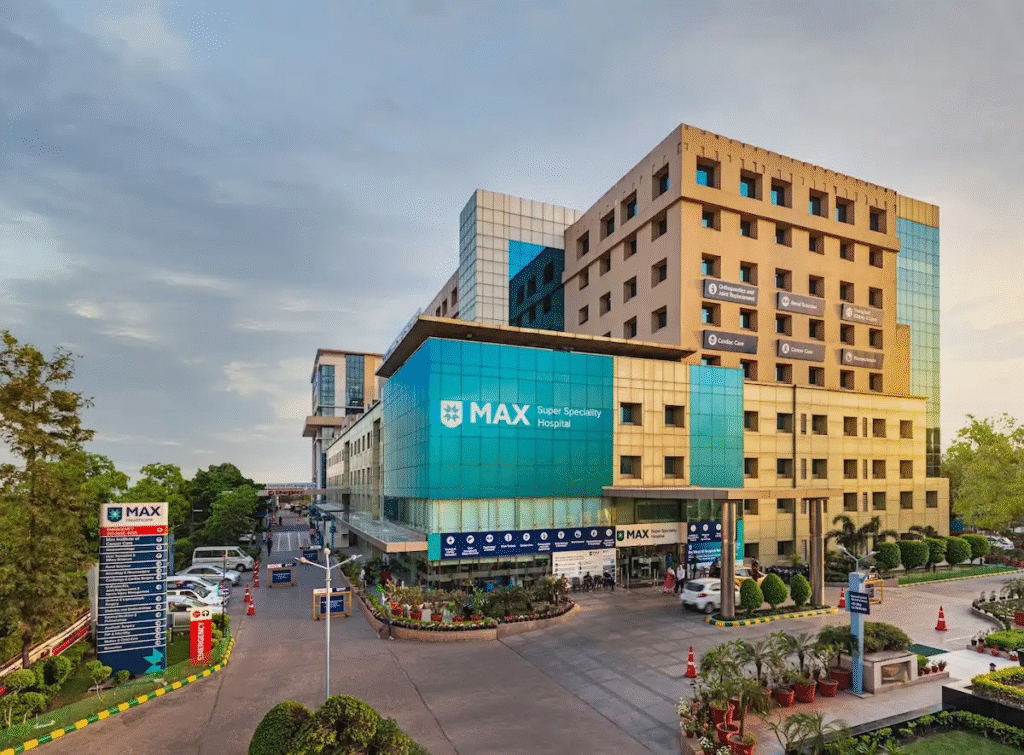1. At a Glance
Max Healthcare is running hospitals like high-frequency trading desks — fast, efficient, and always in the green. Q1 FY26 revenue hit ₹2,574 Cr, up 27% YoY, EBITDA ₹613 Cr (+23%), PAT ₹345 Cr (+17%). They’re building a 130-bed Dehradun hospital by 2028 for ₹170–200 Cr, because apparently “healthcare tourism” is the next big thing in the hills. P/E? A spine-chilling 103 — enough to make your portfolio ask for oxygen.
2. Introduction
Hospitals used to be places you visited reluctantly; now, they’re billion-rupee businesses with expansion plans rivaling luxury hotel chains. Max Healthcare, India’s second-largest hospital network, is the poster child of corporate medicine — premium locations, premium pricing, and premium returns.
The company’s Q1 FY26 results are a clean bill of health for shareholders: top-line up 27%, margins holding steady at ~24%, and steady bed additions. The new Dehradun project adds to their aggressive expansion map, aiming for high-value patient markets.
But let’s not pretend this is a charity — Max runs a medical monetization machine. From radiology to super-speciality surgeries, every department has its own P&L obsession. With the insurance sector growing and urban India demanding top-tier care, Max is sitting in the sweet spot.
Still, at a P/E north of 100, the market is basically pricing inimmortality. This isn’t a “value buy” — it’s a “valuation dare”. One earnings miss, and the stock could need its own defibrillator.
3. Business Model (WTF Do They Even Do?)
Max Healthcare operates an integrated healthcare delivery network:
- In-patient services– surgeries, ICUs, speciality wards.
- Out-patient services– consultations, day care treatments, diagnostics.
- Diagnostics & pathology– MRIs,
- CT scans, lab tests.
- Hospital management– leasing/operating facilities for faster footprint growth.
The strategy is simple — put high-end hospitals in rich or high-density urban areas, tie up with insurers, run at high occupancy, and maintain brand perception as “premium care”.
The economics? Once fixed costs (staff, equipment) are covered, each additional patient is almost pure profit. That’s why EBITDA margins stay healthy at 24–27%.
4. Financials Overview
| Metric | Q1 FY26 | Q1 FY25 | Q4 FY25 | YoY % | QoQ % |
|---|---|---|---|---|---|
| Revenue (₹ Cr) | 2,574 | 2,027 | 1,910 | 27.0% | 34.8% |
| EBITDA (₹ Cr) | 613 | 498 | 512 | 23.0% | 19.7% |
| PAT (₹ Cr) | 345 | 295 | 319 | 16.9% | 8.1% |
| EPS (₹) | 3.45 | 2.95 | 3.28 | 16.9% | 5.2% |
Margins are holding steady, showing Max isn’t discounting services to grow — they’re charging more and still filling beds.
5. Valuation (Fair Value Range)
- P/E Method:EPS TTM ₹11.81 × sector multiple (60–75x) → ₹709–₹886.
- EV/EBITDA Method:EBITDA TTM ₹1,984 Cr, Net Debt ₹1,551 Cr, EV/EBITDA 25–30x → ₹675–₹810.
- DCF:18% CAGR (5 yrs), WACC 10%, terminal growth 4% → ₹720–₹900.
Fair Value Range:₹700–₹900 (Educational only, not investment advice).CMP ₹1,267




















